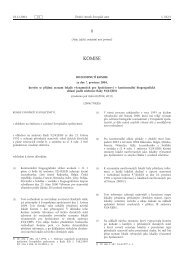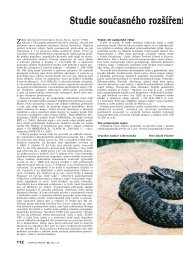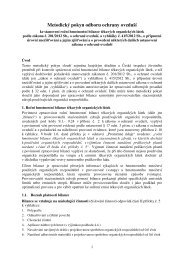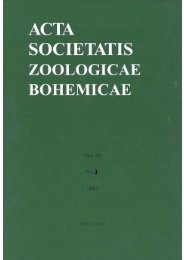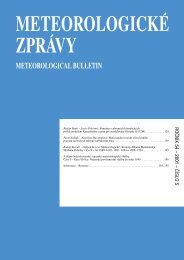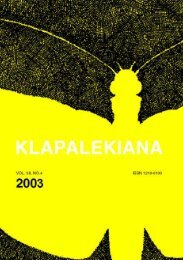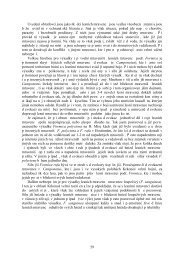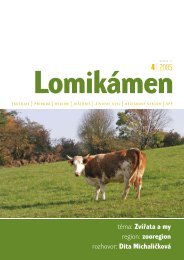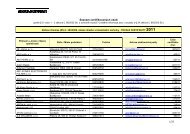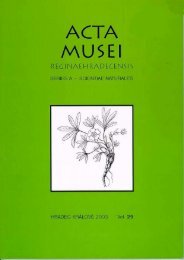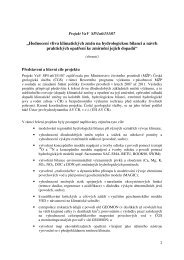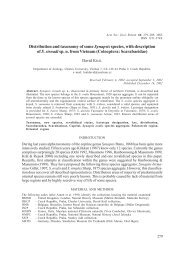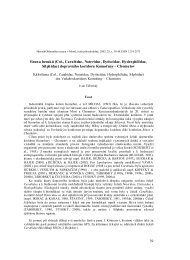journal of forest science
journal of forest science
journal of forest science
Create successful ePaper yourself
Turn your PDF publications into a flip-book with our unique Google optimized e-Paper software.
nuses were very variable, and they amounted to 10–30%<br />
for the whole period and all operations. or the period <strong>of</strong><br />
investigation wage tariffs changed the most <strong>of</strong> all, when<br />
in felling they increased by 289%, skidding by 311%,<br />
handling by 317% and transportation by 344%. Unanimously,<br />
for the whole period, the coefficients <strong>of</strong> conversion<br />
<strong>of</strong> wage costs to direct costs have increased. Their<br />
development according to the respective operations was<br />
not the same and their values have not increased so significantly<br />
as for wage tariffs. or all operations their values<br />
have increased by about 40–80% since 1988.<br />
Tables 2–6 present aggregate coefficients <strong>of</strong> costs that<br />
were calculated as a product <strong>of</strong> wage tariffs, coefficient<br />
<strong>of</strong> additional charges to basic man-hours, bonuses to basic<br />
wage and conversion coefficient <strong>of</strong> wage costs to direct<br />
costs. Aggregate coefficient is expressed in SKK per<br />
1 man-hour <strong>of</strong> work separately in each operation. One<br />
exception is other related operations, in which aggregate<br />
coefficients <strong>of</strong> costs are expressed in SKK per 1 m 3 <strong>of</strong><br />
felled timber. Based on the aggregate coefficients <strong>of</strong> costs<br />
according to calendar years also their indexes were calculated<br />
as the ratios <strong>of</strong> coefficient in the respective calendar<br />
year to the coefficient in the basic year 1988. The<br />
development <strong>of</strong> these indexes is illustrated in ig. 6. Regarding<br />
their values the indexes <strong>of</strong> costs <strong>of</strong> felling and<br />
skidding were increasingly growing and had a relatively<br />
balanced trend. In the final year 1997 the costs <strong>of</strong> these<br />
two operations increased 4.0–4.4 times in comparison<br />
with the basic year 1988. The costs <strong>of</strong> timber transportation<br />
increased very rapidly, particularly by the year 1992,<br />
when they were higher 3.7 times. or the whole period<br />
<strong>of</strong> investigation the costs <strong>of</strong> transportation were 4.5 times<br />
higher than in 1988. Of all operations the highest increase<br />
in costs was recorded for handling. or 9 years <strong>of</strong> investigation<br />
the costs <strong>of</strong> this operation increased more than<br />
5.7 times. The lowest increase in costs was recorded in<br />
other logging operations, where the costs increased only<br />
2.3 times for the period <strong>of</strong> investigation, which is about<br />
a half trend <strong>of</strong> the handling costs. Providing that we do<br />
not consider the costs <strong>of</strong> other logging operations and<br />
assess only four main operations, we can state that the<br />
costs increased 4.0–5.7 times for the years 1988–1997.<br />
We can state on the basis <strong>of</strong> comparison <strong>of</strong> price and<br />
cost indexes that in 1988–1997 timber prices increased<br />
by about 2.7–3.8 times according to quality classes <strong>of</strong><br />
logs but the costs <strong>of</strong> respective logging operations increased<br />
4.0–5.7 times. The exception is the costs <strong>of</strong> other<br />
logging operations, which increased only 2.3 times. This<br />
difference in the increase <strong>of</strong> timber prices and costs <strong>of</strong><br />
logging indicates unanimously their growing disproportion.<br />
This situation is also reflected in the values <strong>of</strong> net<br />
yields <strong>of</strong> spruce stands.<br />
DISCUSSION<br />
The trends <strong>of</strong> unit prices <strong>of</strong> spruce raw timber according<br />
to quality and diameter classes <strong>of</strong> logs are assessed in<br />
the paper as well as the trend <strong>of</strong> spruce timber costs ac-<br />
cording to the respective logging operations in the Slovak<br />
Republic for the years 1988–1997. It is obvious from<br />
the results that the prices <strong>of</strong> spruce timber for main assortments<br />
increased 2.7–3.8 times but the costs <strong>of</strong> logging,<br />
including transportation to the customer, increased<br />
4.0–5.7 times. It means that the increase in the costs <strong>of</strong><br />
logging for nine years <strong>of</strong> investigation was higher 1.3–<br />
1.9 times than for unit prices <strong>of</strong> spruce timber assortments.<br />
This fact is very important and simultaneously<br />
very unfavourable for current <strong>forest</strong>ry. The increase in<br />
timber prices and the costs <strong>of</strong> logging was not the same<br />
for the whole period <strong>of</strong> investigation. The highest increase<br />
in timber prices was recorded until 1992, when<br />
the prices for most assortments increased about 2.2–<br />
2.7 times, while the prices <strong>of</strong> saw logs, the most demanded<br />
assortment, increased even 3 times. The costs <strong>of</strong> logging<br />
for that period increased only 2 times. It means that<br />
the increase in timber prices was slightly greater than the<br />
increase in logging costs. After 1992 the increase in timber<br />
prices slowed down but the costs <strong>of</strong> logging operations<br />
continued to grow at the same pace as before. It<br />
was caused by the balanced increase especially in wage<br />
tariffs. Though the paper was aimed particularly at the<br />
analysis <strong>of</strong> the trends <strong>of</strong> the prices <strong>of</strong> spruce timber assortments<br />
and logging costs for the years 1988–1997, it<br />
is possible to obtain also more general related information<br />
and to forecast future trends. Though spruce timber<br />
has very good technical and technological properties, it<br />
is very improbable that its price will increase at the same<br />
pace as in the period <strong>of</strong> 1990–1992. We expect a slight<br />
increase gradually up to the balance with higher prices in<br />
neighbouring countries. The increase in the costs <strong>of</strong><br />
spruce timber logging is relatively strong and permanent.<br />
Regarding the continuous increase in the living costs, we<br />
can also expect a permanent pressure on the increase <strong>of</strong><br />
wage tariffs and wage costs. Regarding these facts, it is<br />
necessary to take into account not only lower yields <strong>of</strong><br />
spruce timber but also the lower rate <strong>of</strong> return in the<br />
whole <strong>forest</strong>ry.<br />
References<br />
HALAJ J., BORTEL J., GRÉK J., MECKO J., MIDRIAK R.,<br />
PETRÁŠ R., SOBOCKÝ E., TUTKA J., VALTÝNI J., 1990.<br />
Rubná zrelos drevín. Lesn. Štúd., 48: 117.<br />
PETRÁŠ R., MECKO J., HALAJ J., NOCIAR V., PETRÁ-<br />
ŠOVÁ V., 1992. Sortimentaèné a hodnotové rastové tabu¾ky<br />
pre smrekovec, hrab a brezu. [Závereèná správa.] Zvolen,<br />
LVÚ: 156.<br />
POLENO Z., 1984. Vývojové tendence produkce a spotøeby<br />
døeva ve svìtì a prognóza vývoje cen surového døíví.<br />
[Závìreèná zpráva.] Jílovištì-Strnady, VÚLHM: 113.<br />
Received 25. November 1999<br />
330 J. FOR. SCI., 47, 2001 (7): 322–330



